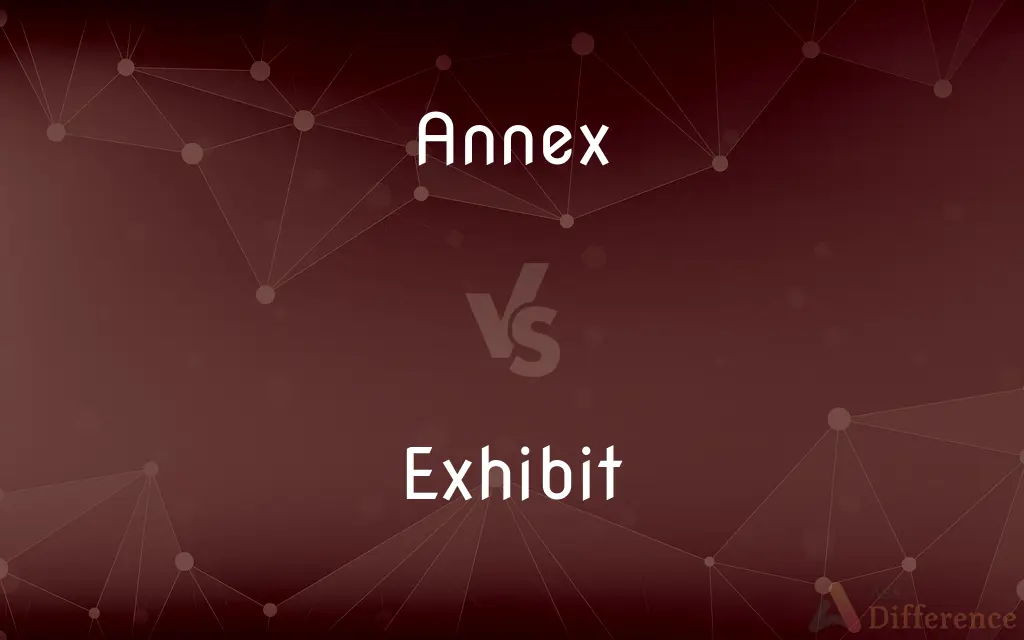Annex vs. Exhibit — What's the Difference?
By Tayyaba Rehman & Maham Liaqat — Updated on March 31, 2024
Annexes are supplementary materials added to the end of a document to support its content, whereas exhibits are items or documents presented as evidence in a legal context.

Difference Between Annex and Exhibit
Table of Contents
ADVERTISEMENT
Key Differences
An annex serves as an addition to a main document, providing supplementary information or data that supports the document's content. It is often used in reports, contracts, and academic papers to include detailed information without cluttering the main text. On the other hand, an exhibit is specifically used in legal proceedings or exhibits in museums or galleries, where it refers to items or documents presented as evidence or for public viewing. These items are directly referenced within the main legal documents, court cases, or displayed with descriptions for educational or informational purposes.
Annexes are generally appended to the end of a document and are considered part of the document itself, enhancing the reader's understanding or providing additional data. They can include charts, tables, or detailed analyses. Whereas, exhibits, in a legal context, are presented during trials or hearings and are used to support a party's argument or to prove a point in a case. They can range from physical evidence to documents or photographs.
In academic or professional reports, annexes are numbered or lettered sequentially and referred to within the main body of the text. This organizational method helps readers easily locate the referenced material. Exhibits, however, are often labeled according to their sequence of presentation in a legal case or the order of their relevance to the case, assisting legal professionals and juries in tracking the evidence.
Annexes can also include additional resources like bibliographies, glossaries, or technical specifications related to the main document. This inclusion helps in extending the document's utility and reference value. Exhibits, in contrast, are curated to influence the viewer's understanding or decision, especially in legal or exhibition contexts, focusing on persuasion or educational value.
While both annexes and exhibits serve to provide additional information, the context and purpose of their use distinguish them significantly. Annexes enhance and complement the main document, whereas exhibits are used to demonstrate, prove, or explain specific points in legal, educational, or exhibition settings.
ADVERTISEMENT
Comparison Chart
Definition
A supplementary material added to a document.
An item or document presented as evidence in legal contexts or displayed in museums.
Context
Reports, contracts, academic papers.
Legal proceedings, museums, galleries.
Purpose
To provide additional information supporting the main content.
To present evidence or for public viewing and education.
Organization
Numbered or lettered sequentially and referenced in the main text.
Labeled according to sequence or relevance to the case or display.
Usage
Enhances understanding or adds data to the main document.
Demonstrates, proves, or explains points in a specific context.
Compare with Definitions
Annex
Additional material appended to a book.
The textbook’s annex provides answers to the exercises.
Exhibit
An item or document used as evidence in court.
The photograph was submitted as Exhibit A in the trial.
Annex
Attachments or appendices to official documents.
The proposal’s annex contained detailed project timelines.
Exhibit
A display or piece shown in a museum or gallery.
The ancient vase was the central exhibit in the Greek history section.
Annex
An extension of a main document containing supplementary information.
The contract had an annex listing all the subsidiary companies.
Exhibit
Documents or physical items used to prove a point in legal cases.
The emails were marked as exhibits in the corporate lawsuit.
Annex
A supplementary document added to the end of a report.
The research report included an annex detailing the raw data.
Exhibit
Evidence presented in legal proceedings.
The lawyer introduced several exhibits to support the case.
Annex
A section at the end of a document for additional resources.
The policy paper's annex included a comprehensive bibliography.
Exhibit
An artifact displayed for public viewing.
The science center’s latest exhibit features interactive technology demonstrations.
Annex
Add as an extra or subordinate part, especially to a document
The first ten amendments were annexed to the Constitution in 1791
Exhibit
To show outwardly; display
Exhibited pleasure by smiling.
Annex
Add (territory) to one's own territory by appropriation
The left bank of the Rhine was annexed by France in 1797
Exhibit
To present for others to see
Rolled up his sleeve to exhibit the scar.
Annex
A building joined to or associated with a main building, providing additional space or accommodation
The school's one-storey wooden annex
Exhibit
To present in a public exhibition or contest
Exhibited her paintings at a gallery.
Annex
An addition to a document
An annex to the report
Exhibit
To give evidence or an instance of; demonstrate
Young musicians eager to exhibit their talent.
A plant that exhibits dimorphism.
Annex
To append or attach, especially to a larger or more significant thing.
Exhibit
To put something on public display.
Annex
To incorporate (territory) into an existing political unit such as a country, state, county, or city.
Exhibit
A public showing; an exhibition
Spent the afternoon at the art exhibit.
Annex
To add or attach, as an attribute, condition, or consequence.
Exhibit
Something exhibited
Each exhibit in the show took hours to assemble.
Annex
A building added on to a larger one or an auxiliary building situated near a main one.
Exhibit
(Law) Something marked for identification with the purpose of being introduced as evidence
Referred to Exhibit A.
Annex
An addition, such as an appendix, that is made to a record or other document.
Exhibit
(Informal) Something used as an example, as when arguing or making a point
You never do your chores—Exhibit A.
Annex
An addition, an extension.
Exhibit
(transitive) To display or show (something) for others to see, especially at an exhibition or contest.
He wanted to exhibit his baseball cards.
Annex
An appendix to a book or document.
Exhibit
(transitive) To demonstrate.
The players exhibited great skill.
Annex
An addition or extension to a building.
Exhibit
(intransitive) To put on a public display.
Will you be exhibiting this year?
Annex
An addition to the territory of a country or state, from a neighbouring country or state, normally by military force.
Exhibit
(medicine) To administer as a remedy.
To exhibit calomel
Annex
To add something to another thing, especially territory; to incorporate.
The ancient city of Petra was annexed by Rome.
Exhibit
An instance of exhibiting.
Annex
To attach or connect, as a consequence, condition, etc.
To annex a penalty to a prohibition, or punishment to guilt
Exhibit
That which is exhibited.
Annex
(intransitive) To join; to be united.
Exhibit
A public showing; an exhibition.
The museum's new exhibit is drawing quite a crowd.
Annex
To join or attach; usually to subjoin; to affix; to append; - followed by to.
Exhibit
(legal) An article formally introduced as evidence in a court.
Exhibit A is this photograph of the corpse.
Annex
To join or add, as a smaller thing to a greater.
He annexed a province to his kingdom.
Exhibit
To hold forth or present to view; to produce publicly, for inspection; to show, especially in order to attract notice to what is interesting; to display; as, to exhibit commodities in a warehouse, a picture in a gallery.
Exhibiting a miserable example of the weakness of mind and body.
Annex
To attach or connect, as a consequence, condition, etc.; as, to annex a penalty to a prohibition, or punishment to guilt.
Exhibit
To submit, as a document, to a court or officer, in course of proceedings; also, to present or offer officially or in legal form; to bring, as a charge.
He suffered his attorney-general to exhibit a charge of high treason against the earl.
Annex
To join; to be united.
Exhibit
To administer as a remedy; as, to exhibit calomel.
Annex
Something annexed or appended; as, an additional stipulation to a writing, a subsidiary building to a main building; a wing.
Exhibit
Any article, or collection of articles, displayed to view, as in an industrial exhibition; a display; as, this exhibit was marked A; the English exhibit.
Annex
An addition that extends a main building
Exhibit
A document produced and identified in court for future use as evidence.
Annex
Take illegally, as of territory;
The Israelis are annexing more and more territory on the West Bank
Exhibit
An object or statement produced before a court of law and referred to while giving evidence
Annex
Take (territory) by conquest;
Hitler annexed Lithuania
Exhibit
Something shown to the public;
The museum had many exhibits of oriental art
Annex
Attach to
Exhibit
Show an attribute, property, knowledge, or skill;
He exhibits a great talent
Exhibit
To show, make visible or apparent;
The Metropolitan Museum is exhibiting Goya's works this month
Why don't you show your nice legs and wear shorter skirts?
National leaders will have to display the highest skills of statesmanship
Exhibit
Show or demonstrate something to an interested audience;
She shows her dogs frequently
We will demo the new software in Washington
Exhibit
Walk ostentatiously;
She parades her new husband around town
Common Curiosities
How does an exhibit function in a legal case?
In a legal case, an exhibit serves as evidence presented to support arguments or prove facts to the court.
Can annexes include graphical data?
Yes, annexes can include charts, graphs, and other forms of graphical data to support the document's content.
Are exhibits only used in courtrooms?
While exhibits are commonly associated with courtrooms, they are also used in museums and galleries for display purposes.
How do annexes benefit academic papers?
Annexes provide detailed supporting information, data, or resources in academic papers, enriching the research without disrupting the main narrative.
What is an annex in a document?
An annex is a supplementary section added to the end of a document to provide additional information without overcrowding the main content.
Why are annexes important in contracts?
Annexes in contracts provide detailed terms, conditions, or specifications that are crucial for clear, comprehensive agreements.
Can anything be considered an exhibit in a legal context?
In a legal context, any item or document that can provide proof or support a claim can be considered an exhibit.
What is the difference between an annex and an appendix?
The terms are often used interchangeably, but an annex is generally more standalone, providing extensive supplementary material, whereas an appendix is more directly tied to the text.
How are exhibits authenticated in court?
Exhibits are authenticated through testimony or evidence that confirms their reliability and relevance to the case.
What makes an exhibit significant in a museum setting?
Exhibits in museums are significant for their educational value, showcasing artifacts or artworks to inform and engage the public.
What considerations should be made when preparing exhibits for a trial?
When preparing exhibits for a trial, considerations should include relevance, clarity, and the ability to conclusively support or refute aspects of the case.
Can digital materials be included as annexes or exhibits?
Yes, digital materials, such as databases, websites, or electronic documents, can be included as annexes in documents or exhibits in legal contexts.
Is there a limit to the number of annexes a document can have?
There is no strict limit, but annexes should be used judiciously to ensure the main document remains coherent and focused.
What role do exhibits play in educational exhibits?
In educational exhibits, they play a crucial role in visual learning, allowing visitors to explore concepts or history through tangible displays.
How should annexes be referenced in a document?
Annexes should be clearly referenced within the main body of the document, usually indicated by numbers or letters for easy navigation.
Share Your Discovery

Previous Comparison
Feverishly vs. Feverously
Next Comparison
Glen vs. HollowAuthor Spotlight
Written by
Tayyaba RehmanTayyaba Rehman is a distinguished writer, currently serving as a primary contributor to askdifference.com. As a researcher in semantics and etymology, Tayyaba's passion for the complexity of languages and their distinctions has found a perfect home on the platform. Tayyaba delves into the intricacies of language, distinguishing between commonly confused words and phrases, thereby providing clarity for readers worldwide.
Co-written by
Maham Liaqat















































